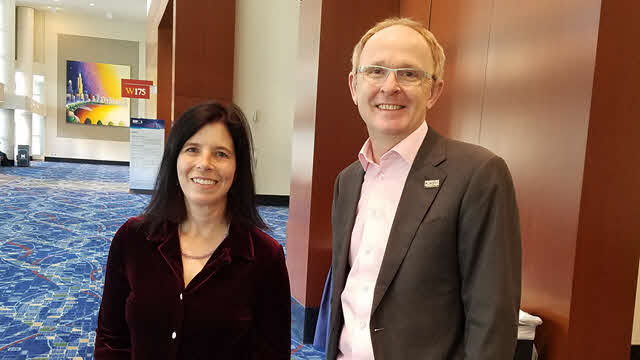Episode 415: Emotional Intelligence Tools for Smoother Projects (Free)
Download Project Management Professional (PMP)® exam prep to your pocket:

Ever feel like your projects would run much more smoothly if everyone just did their job without nagging?
Help is on the way.
Emotional intelligence is the way to really connect with everyone on your team. Take project management to the next level using emotional intelligence principles to guide your interactions and activities. Today we discuss practical applications of emotional intelligence for everything from communications to meetings to celebrations to managing remote teams.
This interview with Kim Wasson (LinkedIn Profile) was recorded at the uplifting Project Management Institute (PMI)® Global Conference 2017 in Chicago, Illinois.
In the interview, we discuss how to apply emotional intelligence concepts to day-to-day project management tasks and activities (i.e., communications, team building, assignments, goals, and priorities) and learn to recognize both emotional intelligence and cultural intelligence signals and use them to tailor communications and daily operations.
Episode Transcript
Below are the first few pages of the transcript. The complete transcript is available to Premium subscribers only.
Podcast Introduction
Kim Wasson: In this episode of The Project Management Podcast™, I’ll show you how to apply emotional intelligence concepts to day-to-day project management tasks and activities like communications, team building, assignments’ goals, priorities, anything you do in project management you can use this for.
Cornelius Fichtner: Hello and welcome to The Project Management Podcast™ at www.pm-podcast.com. I am Cornelius Fichtner.
Podcast Interview
Cornelius Fichtner: We are coming to you live from the uplifting 2017 PMI Global Conference here in Chicago. And with me right now here in the hallways of the conference center is Kim Wasson. Hello, Kim!
Kim Wasson: Hello, Cornelius!
Cornelius Fichtner: Good morning! How are you?
Kim Wasson: I am just fine!
Cornelius Fichtner: Just fine. This room over there, 175, that’s where you will be presenting tomorrow.
Kim Wasson: That’s where I will be tomorrow. Indeed!
Cornelius Fichtner: Okay! Yes and I am now officially going to complain to PMI about the distances one has to walk here. I am going to bring my hiking boots next year!
Kim Wasson: It’s really hard to get from place to place but I don’t have to use the gym here.
Cornelius Fichtner: So ladies, do not wear high heels. Wear something comfortable. And Jen, same goes for you.
Your topic is Emotional Intelligence from Chocolates to Video Conference --- EI Tools for Smoother Projects. Okay! First of all, EI tools.
Kim Wasson: Yes, well! Sometimes it’s EQ. Sometimes it’s EI. They are kind of interchangeable but it’s emotional intelligence so EI is kind of the abbreviation but EQ is like IQ.
These are tools…I’m really trying to focus in on the practical tools. I want to hand people things to walk out with to build up their tool kit to use these things.
Cornelius Fichtner: Wonderful! So emotional intelligence, soft skill, touchy, feely, you’re giving us the tools, are you finally making us use hard tools to do all these soft skill things?
Kim Wasson: Yes, that’s the idea!
Cornelius Fichtner: Oh wonderful! We project managers love you!
Kim Wasson: Exactly! That’s what I’m finding. Everybody feels…last year when I presented, I had a lot of people find me afterwards and say: “That was great! I really loved your presentation. Do I really have to do this?” And it became pretty obvious that the more concrete tools I can give people, the more comfortable they are going to be using them.
Cornelius Fichtner: Okay, so why should we care?
Kim Wasson: Why should we care? Well obviously if you already like the people side of project management, this just gives you some more tools. But if process is really what you like, you have to realize that just because it’s a process, people aren’t going to use it, right? So in order to make your beautiful processes work, you have to figure out how to make people want to use the process. If it doesn’t make sense to them, if they don’t see the benefit, they are going to round it. So no matter which side you come down on, projects are really people and you got to be able to use these tools.
Cornelius Fichtner: On one of your slides in the opening, you have a true example. What is the true example?
Kim Wasson: I coach project managers both new and experienced. I had a new project manager the Client Company and his first project was to port an application, an IT application, internal application for use in Europe. And he understood the application in the US he’d done support for. And they use an Agile process at this Client Company and he was working with an outsourced company that he uses often.
The outsource company brought in a new project manager for this. She wasn’t brand new. She was new to the company. And she had worked in a hardware environment at a printer plant. He could not get her to use Agile. The user stories would drag. There was nothing to show the business unit who really needed to see it and see what adjustments they needed to make. They want working in priority order and he wouldn’t talk to her about it. He said: “It’s a process. She has to use it. But she is not using it. You have to talk to her about it. No, it’s the process, she has to use it.”
So finally at 3 months it took me and he didn’t talk to her. But he had me talk to her. And I didn’t tell her the process. She knew the process. But I told her every step of the process, what it would do for the project and what it would do for her team, what’s the benefit to her team. And that was fine! Then she followed it to the letter because she was brand new to the company. This was how she was proving herself to use a process she had never used before which as far as she know, it wasn’t going to work. She had to prove herself and she was using the processes that had worked for her before.
So as soon as we turned it around and said: “No, you’re going to be successful, here’s how.” She was fine. So that’s really all it took. It took half an hour and she was good.
Cornelius Fichtner: Alright! Learning and walking styles, why are they important for our discussion today?
Kim Wasson: This is one of the best tools that I have. People taking information and this is not only behavioral science. This is actually neuroscience now. People take information best in one or possibly two of five ways. They can take it in in all of them but we’re all really busy and we’re going to look for the ways very easiest so that people that we communicate as project managers are going to look for their easiest way. So we need to figure out what their easiest ways are and present information in as many ways as possible.
It sounds really hard and it sounds really time consuming but it’s not. It means that we need to outline our minutes and put Italic and Bold in there so that people who do reading are going to read them but the people who do visual can pick out the points without putting it away, otherwise…
Cornelius Fichtner: You’ve just given us two of the learning styles, right, visual and reading, okay?
Kim Wasson: Visual and reading are two of the learning styles. The reading people are the ones who always answer your email. You can send them anything in email. They are going to read it. They are going to get back to you.
Auditory learners are never going to look at your emails unless they absolutely have to. But if you pick up the phone, they will be right there. They’ll answer on the first ring. They’ll give you anything they need.
Cornelius Fichtner: And they’ll listen to this Podcast too.
Kim Wasson: Yes, they will. Actually I send lots of people to your Podcast but particularly the people that I work with who are auditory learners because this is how they get their information. This is what they like the best. It’s hard for people who aren’t auditory learners. Podcasts could be hard to focus on which is why a lot of people do it when they are driving because there are enough other occupation but not enough distractions, yeah!
The other kinds, so we’ve got visual. They like colors, graphs. So you send them stuff that they can take in quickly, absorb quickly. The reading people like email. The auditory people you have to talk through things. You never say to an auditory person: “Oh you can read the slide.” Because they won’t.
And then there are tactile people who need to touch information. They are the ones you bring the handouts for. They are the ones who go to a whiteboard.
And there are kinetic learners who have to move the information or move them. And I’m one of them. My hands are always going, I’ll be the one tapping my foot. So kinetic learners will also take notes because that’s moving. They like whiteboards a lot. You can tell the difference at a whiteboard between a kinetic and a tactile learner because the tactile learner writes and puts the pen down and the kinetic learner keeps the pen and fiddles with it.
So knowing the people learn in these ways, you can start to present your information specific to the people in different ways, right, show up for the person who doesn’t answer email for the auditory person or pick up the phone. But when you are doing things like minutes and presentations, you can accommodate all of these learning styles pretty easily if you know that they exist.
Cornelius Fichtner: How do I involve tactile people in a video conference? It seems a bit difficult because they are at the other end of the world.
Kim Wasson: It is a bit difficult. If you provide materials ahead of time, tactile people will always print them off and they’ll write on them. If you provided them a transcript of what you are going to say, they would still make notes because that’s how they touch the information. So the more information you can provide ahead of time, the better off you’re going to be.
Cornelius Fichtner: How can I find my own style so that I know what works for me?
Above are the first few pages of the transcript. The complete PDF transcript is available to Premium subscribers only.
PDUs: Power Skills, PMI Global Conference, PMI Global Conference 2017

